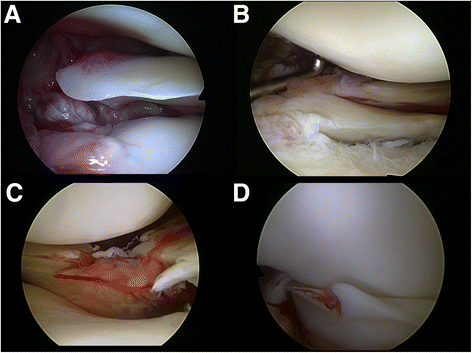Associated tears of the lateral meniscus in anterior cruciate ligament injuries: risk factors for different tear patterns
- PMID: 25889148
- PMCID: PMC4389969
- DOI: 10.1186/s13018-015-0184-x
Associated tears of the lateral meniscus in anterior cruciate ligament injuries: risk factors for different tear patterns
Abstract
Background: The pattern of lateral meniscus tears observed in anterior cruciate ligament (ACL)-injured subjects varies greatly and determines subsequent management. Certain tear patterns with major biomechanical consequences should be repaired in a timely manner. Knowledge about risk factors for such tears may help to identify patients in the early posttraumatic phase and subsequently may improve clinical results.
Methods: A database of 268 patients undergoing primary ACL reconstruction was used to identify all patients with isolated ACL tears and patients with an associated tear of the lateral meniscus. Patients who underwent surgery >6 months after the injury were excluded. Based on the arthroscopic appearance of the lateral meniscus, patients were assorted to one of three groups: 'no tear,' 'minor tear,' and 'major tear.' Tear patterns defined as major included root tears, complete radial tears, and unstable longitudinal tears including bucket-handle tears. Univariate analysis was performed by comparing the three groups with regard to gender, age, height, weight, BMI, type of injury (high-impact sport, low-impact sport, and not sports related), and mechanism of injury (non-contact vs. contact). Multivariate logistic regression was carried out to identify independent risk factors for minor and major meniscal tears and to calculate odds ratios (OR).
Results: Two hundred fifteen patients met the inclusion and exclusion criteria. Of those, 56% had isolated ACL tears, 27% had associated minor tears, and 17% had associated major tears of the lateral meniscus. Univariate analysis revealed significant differences between the three groups for gender (p = 0.002), age groups (p = 0.026), and mechanism of injury (p < 0.001). A contact injury mechanism was a risk factor for minor tears (OR: 4.28) and major tears (OR: 18.49). Additional risk factors for major tears were male gender (OR: 7.38) and age <30 years (OR: 5.85).
Conclusion: Male patients, patients <30 years, and particularly patients who sustained a contact injury have a high risk for an associated major lateral meniscus tear. Special attention is therefore necessary in those patients and early referral to magnetic resonance imaging and/or arthroscopy is recommended to allow meniscus repair in a timely manner.
Figures


Similar articles
-
Risk factors for posterior lateral meniscus root tears in anterior cruciate ligament injuries.Knee Surg Sports Traumatol Arthrosc. 2015 Jan;23(1):140-5. doi: 10.1007/s00167-014-3280-2. Epub 2014 Sep 6. Knee Surg Sports Traumatol Arthrosc. 2015. PMID: 25193573
-
Meniscal and chondral injuries associated with pediatric anterior cruciate ligament tears: relationship of treatment time and patient-specific factors.Am J Sports Med. 2012 Sep;40(9):2128-33. doi: 10.1177/0363546512449994. Epub 2012 Jun 22. Am J Sports Med. 2012. PMID: 22729621
-
Meniscal tears missed on MR imaging: relationship to meniscal tear patterns and anterior cruciate ligament tears.AJR Am J Roentgenol. 1994 Apr;162(4):905-11. doi: 10.2214/ajr.162.4.8141016. AJR Am J Roentgenol. 1994. PMID: 8141016
-
Arthroscopic meniscal repair with use of the outside-in technique.Instr Course Lect. 2000;49:195-206. Instr Course Lect. 2000. PMID: 10829175 Review.
-
Associated injuries in pediatric and adolescent anterior cruciate ligament tears: does a delay in treatment increase the risk of meniscal tear?Arthroscopy. 2002 Nov-Dec;18(9):955-9. doi: 10.1053/jars.2002.36114. Arthroscopy. 2002. PMID: 12426537 Review.
Cited by
-
Meniscal injuries in children and adolescents undergoing surgical treatment for tibial eminence fractures.Knee Surg Sports Traumatol Arthrosc. 2017 Feb;25(2):445-453. doi: 10.1007/s00167-016-4184-0. Epub 2016 May 27. Knee Surg Sports Traumatol Arthrosc. 2017. PMID: 27234381
-
Anatomic characteristics of the knee influence the risk of suffering an isolated meniscal injury and the risk factors differ between women and men.Knee Surg Sports Traumatol Arthrosc. 2021 Nov;29(11):3751-3762. doi: 10.1007/s00167-020-06396-5. Epub 2021 Jan 3. Knee Surg Sports Traumatol Arthrosc. 2021. PMID: 33388828
-
The Role of Crutches and Bracing in Preventing Secondary Meniscal Tears After Anterior Cruciate Ligament Injury in Pediatric Patients.Orthop J Sports Med. 2025 Feb 6;13(2):23259671241309862. doi: 10.1177/23259671241309862. eCollection 2025 Feb. Orthop J Sports Med. 2025. PMID: 39944767 Free PMC article.
-
Reliability of magnetic resonance imaging in evaluating meniscal and cartilage injuries in anterior cruciate ligament-deficient knees.Knee Surg Sports Traumatol Arthrosc. 2017 Feb;25(2):411-417. doi: 10.1007/s00167-016-4211-1. Epub 2016 Jun 24. Knee Surg Sports Traumatol Arthrosc. 2017. PMID: 27342983
-
The Lateral Meniscus Oblique Radial Tear (LMORT).Curr Rev Musculoskelet Med. 2023 Jul;16(7):306-315. doi: 10.1007/s12178-023-09835-1. Epub 2023 Apr 22. Curr Rev Musculoskelet Med. 2023. PMID: 37086383 Free PMC article. Review.
References
-
- Smith JP, 3rd, Barrett GR. Medial and lateral meniscal tear patterns in anterior cruciate ligament-deficient knees. A prospective analysis of 575 tears. Am J Sports Med. 2001;29:415–9. - PubMed
Publication types
MeSH terms
LinkOut - more resources
Full Text Sources
Other Literature Sources
Medical
Miscellaneous

